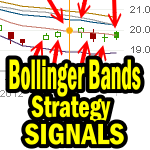The Bollinger Bands Strategy can provide explosive profit potentials for short-term risk to capital, but for it to work properly, investors have to be consistent in the strategy and not attempt to second-guess the signals. My recent Intel Stock Bollinger Bands Strategy trade is a good example of why the Bollinger Bands Strategy works so well for my portfolio. By following the signals, this strategy can provide excellent profits while at the same time, it can warn in advance of a change in the strategy to allow time to exit from a trade with minimal loss or small gains.
This morning my Intel Stock Bollinger Bands Strategy Trade was ended with a small loss. In this article I explain the ongoing Bollinger Bands Strategy Trade as it pertained to Intel Stock and why, despite their being a good chance of success, the signals have to be followed and the trade ended. This article for FullyInformed Members is of significance in understanding the workings of the Bollinger Bands Strategy and how to read the signals and implement them to remain consistent in the strategy for profit and protection.
This article looks at Intel Stock and compares it to a similar trade in Clorox Stock to show how both Bollinger Bands Strategy trades gave signals important to the investor in understanding when to stay in the trade and when to leave. One of the supporting technical indicators for the Bollinger Bands Strategy is the Slow Stochastic technical indicator which is key to the Bollinger Bands Strategy success. This article studies the Bollinger Bands Strategy along with the including of the Slow Stochastic Technical Tool.
This FullyInformed Members Strategy Article can be directly accessed through this link or Members can login here. Non-members can join here. This article is 8 pages in length containing 1913 words.

